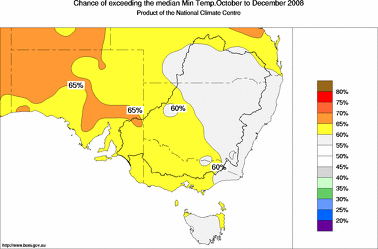|
The pattern of seasonal temperature odds across southeastern Australia
reflects a strong contribution from the Indian Ocean where continued
warmth exists in the central and southeastern Indian Ocean, especially
off the west coast of Western Australia. Although there has been some
warming in recent months in the equatorial Pacific, it is generally in
a neutral state, and not contributing to any significant shifts in the
odds for the temperature outlook in southeastern Australia.
Averaged over October to December, the chance of exceeding the median
maximum temperature is mainly between 60 and 75% for much of New South
Wales and South Australia. The chances of above average maximum temperatures
increases to 75 to 85% over southeastern parts of South Australia, southern
NSW, Victoria and Tasmania (see map).
This means for every 10 years with ocean patterns like the current, about
six to eight years are expected to be warmer than average during the day,
while about two to four are expected to be cooler.
Outlook confidence is related to how consistently the Pacific and Indian
Oceans affect Australian temperatures. During October to December, history shows this
effect on maximum temperatures to be moderately consistent over much of northern
and western NSW, most of SA and the northern half of both Victoria and Tasmania.
However, over a large part of eastern NSW, southern Victoria and southern
Tasmania confidence is only weakly consistent, so this outlook needs to be
used with caution in these areas (see background information).
There is a moderate shift in the odds towards warmer than average October
to December minimum temperatures, with nights favoured to be slightly warmer
than normal across much of southeastern Australia (see map). The chances of
increased overnight warmth (averaged over the coming three months) are around
60% for NSW, Victoria and Tasmania. The odds increase to 65% over much of South
Australia, particularly the NW corner.
This means for every ten years with ocean patterns like the current, about
six to seven would be expected to be warmer than average in terms of overnight
temperatures averaged over October to December, while three to four would be
expected to be cooler.
History shows the oceans' effect on minimum temperatures from October
to December to be moderately consistent over most of SA, NSW and
northwestern and southern Tasmania. However, over most of Victoria,
most of southeastern NSW, southeastern SA and central Tasmania the
effect is generally only weakly consistent, so this outlook needs to
be used with caution in these areas.
|  |











